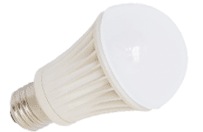What is one of the biggest things you can do to your home to save energy, money and your time?
Answer: Replace your lightbulbs with LED bulbs next time those old incandescents burn out.
For the past couple years I have been changing over the bulbs in our home. It is easy to do with the replacement bulbs I buy online from LEDwaves.com. They are designed for the same type socket and voltage as the old incandescent bulbs, so they fit right into your recessed fixtures, table lamps, etc. No need to deal with costly low voltage systems or their noisy and hot transformers.
The best part of the switch is what it saves you. LED bulbs use about an eighth the electricity as the old incandescent bulbs (about half the electricity as the so-called 'energy saver' compact fluorescent bulbs). And they last far longer, a typical replacement LED lasts about 40,000 hours, compared to the 2,000 hour lifespan of the old incandescent. Once you replace a bulb, you may never change it again (a great feature for those high ceiling, hard to reach lights).
The one downside is the initial cost of the bulb. Since I buy mine online before I need them, I am able to take advantage of occasional sales or bulk orders. It works out to about $25 per bulb, but since I have been changing the bulbs over in our house as they burn out, I am not hit with the huge cost of doing all of the lights in our house at once. Even with the big upfront cost though, it is still far less expensive over the life of the bulb, when you factor in the electricity savings.
Do the math:
For example, an 8 watt LED bulb that lasts 40,000 hours will use 320 kWh. Let's assume you are paying 10 cents per kWh, that would be $32 worth of electricity, plus the $25 for the cost of the bulb, for a total cost of $57 over the life of the bulb. Now compared to the old incandescent bulb, the same light output would be a 60 watt bulb over the same 40,000 hour period would use 2,400 kWh. That translates into $240 of electricity used - but wait, that is not even the worst part. Since the old incandescent bulbs only last about 2,000 hours (if your lucky and haven't bought a cheaply made one that burns out sooner or pops from a power surge when you turn it on), you will need to buy 20 lightbulbs AND change that lightbulb twenty times. That's a lot of work and a big hassle when they burn out at the most inappropriate times. So, to complete the thought on cost, 20 cheap bulbs at about $1 each, added to the electricity cost of $240 is a total of $260 over the same time period. That is over four times the cost of the LED bulbs, which will only get worse as electricity costs go up.
When you consider that lighting is typically the single biggest electricity drain in your house, changing over your lightbulbs can significantly reduce energy, money and your time. My house is almost completely switched over by now and my electric bills are 40% less than what they used to be. Start switching and you will be as pleased as me (and if you really want to reduce your lighting costs, pull back a few curtains on your windows - let some nature light in, you might even enjoy the view).

No comments:
Post a Comment